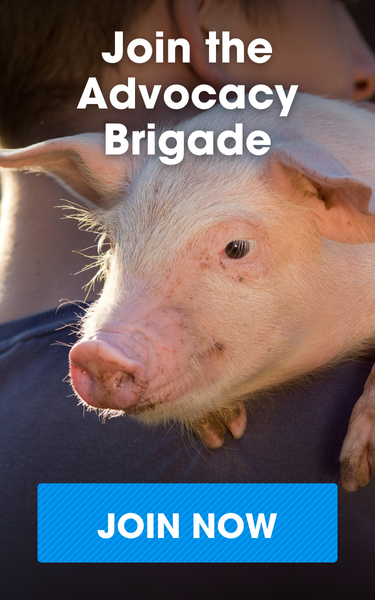
Why Are Factory Farmed Products So Cheap?

If you’ve ever tried to find animal welfare-certified, pasture-based or other more humane alternatives to factory farmed meat, eggs or dairy, you’ve probably noticed a price increase. You may wonder why the more humane products cost more—but the real question is, “Why are factory farmed products so cheap?”
The true cost of factory farmed products isn’t reflected in their prices at the store. Here are a few reasons why factory farmed food is artificially cheap:
1. Factory Farming Treats Animals Like Inanimate Objects
On factory farms, hens are packed four or five birds to a cage without enough room to even spread their wings. Mother pigs spend almost their entire lives in crates so small that they can’t turn around. On higher-welfare farms, farmers spend more on land and facilities so their animals have room to explore, exercise, play and carry out natural behaviors like perching, wallowing and foraging.
2. Factory Farming Is Supported by Government Handouts
Animals on factory farms are fed unnatural, high-calorie diets to help them gain weight faster. Cows are ruminant animals meant to eat grass; in the factory farming system they are force-fed corn and soy, which cause painful ulcers and abscesses. These types of commodity crops are heavily subsidized by the federal government, bringing down costs. On higher-welfare farms, animals are fed healthy, natural diets, which cost significantly more and require more land for grazing.
3. Factory Farming Systems Monopolize the Supply Chain
Factory farms generally operate within what’s known as a vertically integrated system, where large companies control the entire supply chain—from the animals on the farm all the way to the processing and distribution plants. This means that factory farms pay significantly less to get their products to market than higher-welfare farms do, allowing them to charge less at the grocery store.
4. Factory Farming Shortens Animals’ Lives, and They Suffer for It
Through intensive genetic selection and limited exercise, chickens, pigs and cows on factory farms grow far more quickly than traditional breeds. A modern meat chicken now reaches market weight in five weeks, a pig takes six months and a cow takes 18 months. This rapid and unnatural weight gain often causes painful lameness and other health issues. Animals on higher-welfare farms grow at slower, more natural rates, meaning it costs more for farmers to take care of them while they’re on the farm.
5. We Pay for Factory Farming in Medical Bills and Taxes
The extreme costs of factory farming are not accounted for in the price at the grocery store. Industrial farming dumps enormous amounts of animal waste into our air and waterways, polluting the drinking water of local communities and causing public health disasters. The overuse of antibiotics to keep these animals alive in sickening conditions has led to an epidemic of antibiotic resistance that is costing consumers their lives. If the cost of cleaning up factory farming’s mess was accounted for, the sticker price of these products would far surpass the higher-welfare alternatives.
When you choose higher-welfare products you’re supporting a better farming system with more humane treatment of animals, more responsible environmental practices and safer products for the public. No hidden costs involved! To learn how to support higher-welfare farms, visit Shop With Your Heart.

